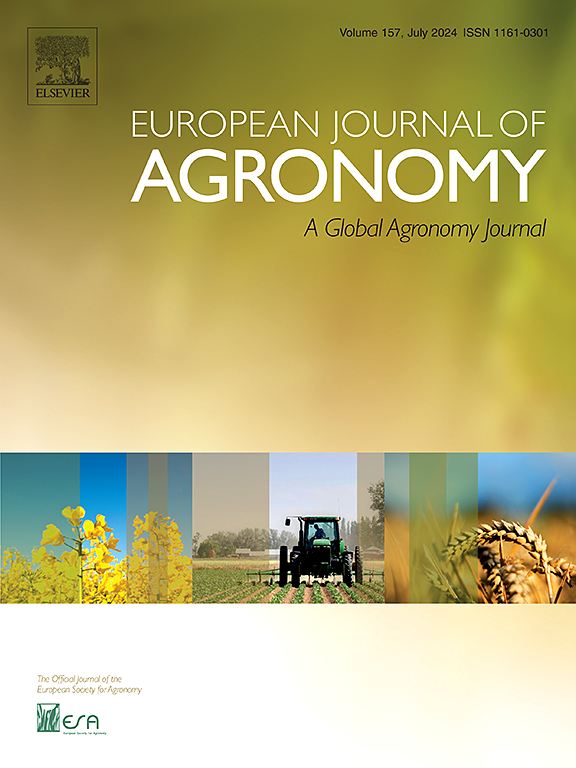基于EPIC的强化氨挥发预测:不同肥料的模型描述与测试
IF 4.5
1区 农林科学
Q1 AGRONOMY
引用次数: 0
摘要
如果生物地球化学模型能够捕捉到农业生态系统中普遍调节氮循环的所有相关过程,那么它是在大空间尺度上评估氨(NH3)挥发减少策略的有希望的经济有效的工具。本工作旨在增强环境政策综合气候(EPIC)模型,以提高其模拟农田中有机和矿质氮肥NH3挥发的能力。现有的EPIC中NH3挥发算法被一个机械子模型所取代,该模型以小时为步长,通过捕获铵(NH4+)吸附、尿素水解、土壤ph将总氨态N分配为NH3和NH4+以及传质等过程,有效地模拟了NH3的挥发。新的EPIC子模型使用来自两个不同地点的数据进行校准和验证(意大利东北部的Legnaro;Eatonton, Georgia, USA),包括几种不同土壤气候条件下肥料类型和施用方法的组合。结果表明,与原始子模型相比,新子模型提供了更准确的累积NH3损失量估算(验证R²= 0.79 vs. 0.50,验证RMSE = 10.6 vs. 17.8 kg N ha−1)。此外,现在的实施可以更准确地模拟肥料类型和管理,包括肥料pH值、施用深度和方法以及液体部分的渗透。综上所述,本文报告的最新EPIC成为评估和选择能够减少NH3挥发的最佳农业实践的有效工具。本文章由计算机程序翻译,如有差异,请以英文原文为准。
Enhanced ammonia volatilization prediction with EPIC: Model description and testing of different fertilizers
Biogeochemical models are promising cost-effective tools to evaluate ammonia (NH3) volatilization reduction strategies at large spatial scales provided they capture all the relevant processes that regulate universally the nitrogen (N) cycle in agroecosystems. This work aims to enhance the Environmental Policy Integrated Climate (EPIC) model to improve its ability to simulate NH3 volatilization from both organic and mineral N fertilizers in agricultural fields. Extant algorithms of NH3 volatilization in EPIC were replaced with a mechanistic submodel that, operating at hourly steps, effectively simulated NH3 volatilization by capturing processes of ammonium (NH4+) adsorption, urea hydrolysis, soil pH-based partitioning of total ammoniacal N into NH3 and NH4+, and mass transfer. The new EPIC submodel was calibrated and validated using data from two different locations (Legnaro, NE Italy; Eatonton, Georgia, USA), including several combinations of fertilizer types and application methods in different pedo-climatic conditions. Results showed that the new submodel provided more accurate estimates of cumulative NH3 loss than the original one (validated R² = 0.79 vs. 0.50, validated RMSE = 10.6 vs 17.8 kg N ha−1). Furthermore, the implementation now enables more accurate simulation of fertilizer types and management, incorporating the effect of fertilizer pH, depth and method of application, and infiltration of the liquid fraction. In conclusion, the updated EPIC reported here becomes an effective tool to evaluate and select best agricultural practices capable of reducing NH3 volatilization.
求助全文
通过发布文献求助,成功后即可免费获取论文全文。
去求助
来源期刊

European Journal of Agronomy
农林科学-农艺学
CiteScore
8.30
自引率
7.70%
发文量
187
审稿时长
4.5 months
期刊介绍:
The European Journal of Agronomy, the official journal of the European Society for Agronomy, publishes original research papers reporting experimental and theoretical contributions to field-based agronomy and crop science. The journal will consider research at the field level for agricultural, horticultural and tree crops, that uses comprehensive and explanatory approaches. The EJA covers the following topics:
crop physiology
crop production and management including irrigation, fertilization and soil management
agroclimatology and modelling
plant-soil relationships
crop quality and post-harvest physiology
farming and cropping systems
agroecosystems and the environment
crop-weed interactions and management
organic farming
horticultural crops
papers from the European Society for Agronomy bi-annual meetings
In determining the suitability of submitted articles for publication, particular scrutiny is placed on the degree of novelty and significance of the research and the extent to which it adds to existing knowledge in agronomy.
 求助内容:
求助内容: 应助结果提醒方式:
应助结果提醒方式:


